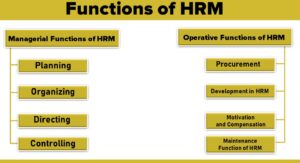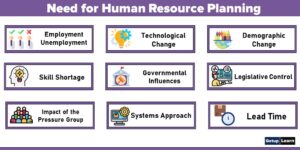Table of Contents
What are the Types of Welfare Measures?
The welfare measures which are undertaken to improve the well-being of the employees can be classified into two categories that are statutory welfare facilities and non-statutory welfare facilities.
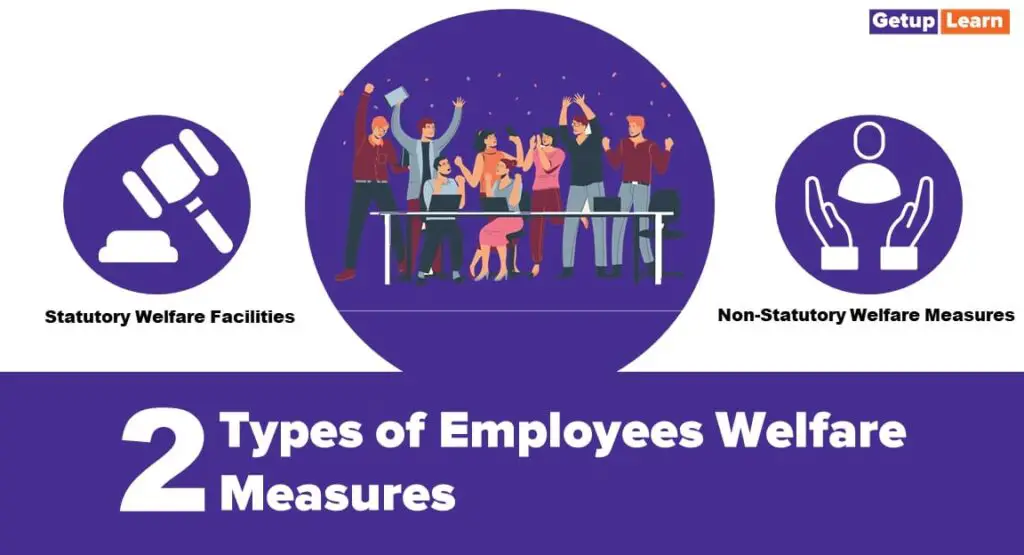
Types of Welfare Measures
The following are types of welfare measures:
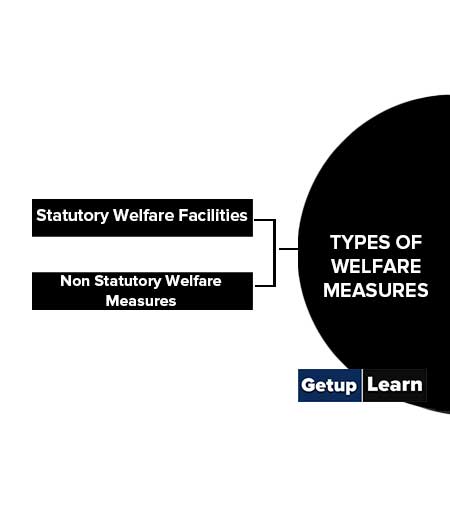
Statutory Welfare Facilities
Statutory welfare facilities are such facilities which have to be undertaken as per certain provisions of the law. There are several acts which are enacted by the government to protect the interests of the employees. Two such acts are:
Factories Act, 1948
The Factories Act, of 1948 was enacted with the purpose of assisting the government to formulate policies with respect to occupational safety and health. This act deals with problems concerning the safety, health, efficiency and well-being of persons at workplaces.
The provisions of this act are applicable to any factory where (1) 10 or more workers are employed and they use electricity and (2) 20 or more workers are employed and they do not use electricity. The following are the important aspects of the act which pertain to employee welfare measures:
- Employers should ensure the welfare including the health and safety of the employees.
- The working place should be neat and tidy and daily sweeping of factory premises should be undertaken.
- Arrangements for drinking water for employees should be made available.
- An Adequate number of toilet facilities should be made available within the premise and they should be kept clean and hygienic.
- Proper washing facilities should be made available inside the factory separately for both males and females.
- A facility for storing and drying clothes should be provided.
- Proper seating arrangements should be made available in case the work which is to be undertaken requires long hours of standing.
- Every factory should have a first aid box which is readily available. For every 150 employees, at least one first aid box should be available.
- In a factory where more than 250 people are employed, a canteen facility should be made available.
- A Sufficient number of shelters, restrooms and lunchrooms with water facilities should be there where more than 150 persons are employed.
- Crèches should be there where the factory employs more than 30 women.
- In A factory employing more than 500 employees, an adequate number of welfare officers should be appointed to supervise the welfare activities.
- Employees fulfilling the necessary conditions should be provided with leave facilities for an appropriate number of days.
- If required, advance payment should be made available to employees who are taking leave for not less than 4 days.
Contract Labour (Regulation and Abolition) Act, 1970
The objective of the contract labour Act, of 1970 is to prevent the exploitation of contract labour and also to introduce better conditions of work the following are the major provisions which deal with employee welfare:
- A contractor who employs 100 or more contract employees must provide one or more canteen facilities on the premises.
- A restroom facility should be provided where work-related night staying by contract employees is required.
- A Sufficient number of drinking water, toilet and washing facilities should be made available.
- First aid facilities should be quickly accessible to all contract employees.
Non Statutory Welfare Measures
Non Statutory facilities are voluntary facilities or they are created by employees themselves through unions and other agencies. Some of these facilities would be available inside the premises and the rest outside the premises.
The following are the non-statutory welfare facilities which are provided to the employees:
- Transport Facilities
- Housing Facilities
- Education Facilities
- Recreation Facilities
- Canteen Facilities
- Insurance Facilities
- FlexiTime Facilities
- Welfare Facilities Inside Factory Premises
- Welfare Facilities Outside Factory Premises
- Women and Child Welfare
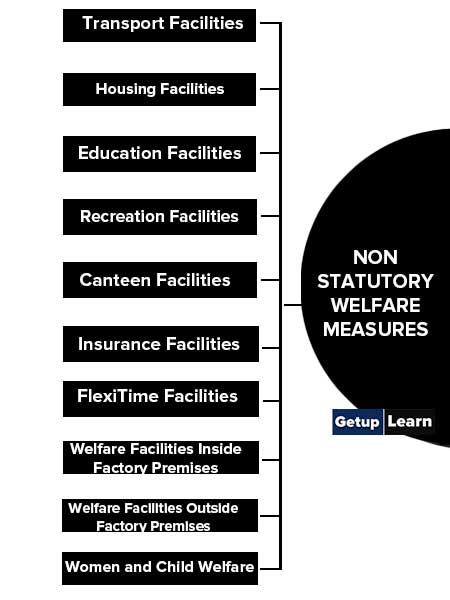
Transport Facilities
Many times organisations provide transport facilities to carry their employees to and from their homes. For this, the organisation can use its own transport vehicle or may hire services of public transport companies. Such services could be either free of cost or at subsidized rates.
Such facilities save time and energy for employees and avoid inconvenience. When transport facilities are made available, the organisation can locate its facilities at locations which are convenient to them. Many times, organisations might also provide petrol allowance to their employees to facilitate them in commuting in their own vehicle.
Housing Facilities
For improving the standard of living of employees, it might be possible for housing facilities can be provided to their employees. If houses are located nearer to the workplace, the employees would reach the workplace punctually. The organisation can allot houses to the employees on a rented basis or they may sanction housing loans to employees so that they can buy their own houses or flats.
Education Facilities
Many times, organisation encourage their employees to pursue further studies in different forms. For this special training programs can be organised or they may sponsor training in any external educational institution. They usually provide reading room facilities, libraries, news bulletins or literary discussion facilities to their employees.
The educational facilities would help the employees to grow in their careers. Educational facilities can also be provided for the children of the employees. For this, the organisation may start their own educational institutions to impart education at subsidized rates or they may provide educational assistance such as scholarships to employees to help them to pursue their studies successfully.
Recreation Facilities
Creation of facilities for playing indoor and outdoor games, music, arts, gym and club membership may also be provided to the employees to keep them physically and mentally strong. These recreation facilities are viewed as stress reduction tools. The games which are chosen should be such that grievous injuries could be avoided.
Canteen Facilities
Many organisations provided subsidized food to their employees. Such canteen could be inside or outside the factory premises. This allows the organisation to help the organisation to ensure that employees do not miss out on having good quality food. It also ensures that the employees do not miss out on work due to bad health which is caused due to unhygienic food.
Insurance Facilities
Organisations provide insurance facilities to employees to cover their medical expenses incurred by them. It can also be taken for compensating losses which might arise out of the death of insured employees. An insurance premium is paid by the organisation on behalf of all employees.
FlexiTime Facilities
Many a times organisations provide facilities to allow employees to at- tend office from their homes. It allows them to take fewer trips to the office. Also, employees can be provided flexible timings to complete their job assignments according to their convenience.
Welfare Facilities Inside Factory Premises
Facilities such as drinking water facilities, toilets, bathing facilities, canteen facilities, first aid and medical facilities, crèches, protective clothes, a reading room and Flexi hours can be provided inside the factory premises.
Welfare Facilities Outside Factory Premises
Facilities such as insurance facilities, transportation facilities, games and sports, education facilities for the employee facilities, housing facilities, guest rooms, club membership, leave travel concessions, cooperative societies and maternity benefits could be provided outside the premises of the organisation.
Women and Child Welfare
Maturity, antenatal and postnatal care and child care, separate service for women workers, that is, lunch area, washrooms, restrooms, women’s recreation (indoor), family planning and welfare measures.
Importance of Employee Welfare Measures
The organisation provide various facilities to their employees as they consider them to be an efficient tool for efficient Human Resource Management. The following are importance of employee welfare measures:
- High Employee Retention
- Improve Productivity and Efficiency
- Better Focus on Work
- Preserve Physical and Mental Health
- Improve Standard of Living
- Cordial Relations
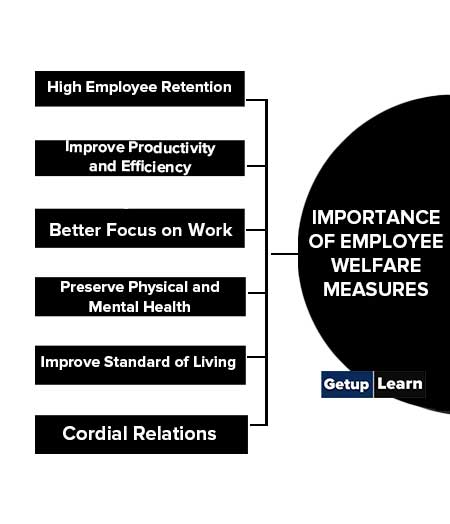
High Employee Retention
The welfare measures which are provided by the organisation create high job satisfaction among them. When employees are satisfied, the employees may not feel the need to quit their job and remain with the organisation for a long time. As a result, labour turnover may also be reduced.
Improve Productivity and Efficiency
Employees who are happy are productive. The welfare activities improve the involvement of the employees and as a result, their productivity and efficiency also increase.
Better Focus on Work
Many times performance of employees is affected by factors such as lack of proper accommodation, low quality of educational facilities, non-availability of quality food at affordable prices, etc. When such problems are addressed by the facilities provided by the organisation then the employees can focus on their work.
Preserve Physical and Mental Health
Sometimes the organisation provide health care and insurance facilities to their employees so that the employees can solve their health-related problems easily. Further routine checkups also help the employees to maintain their health and address health problems at an early stage. As a result, the physical and mental health of the employee is maintained.
Improve Standard of Living
When facilities such as better, housing, proper education and transport facility, nutritious food and health care are provided to employees, their standard of living improves.
Cordial Relations
When the organisation ensures that the employee is comfortable in the work environment, the overall satisfaction of the employee increases. Due to this, the relations between the employees and employers im- prove. This also ensures that the goals of the organisation are achieved in an effective manner.
Disadvantages of Employee Welfare Measures
The following are the disadvantages of employee welfare measures:
- High Labour Cost
- Absence of Measurement Tool
- Expenditure cannot be Justified
- Compulsion of Creation of Facilities
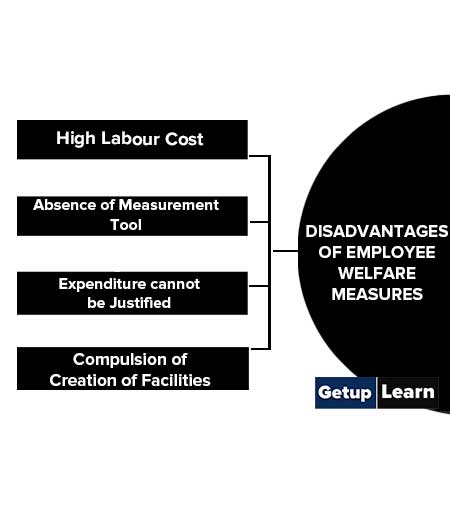
High Labour Cost
Employee welfare measures are provided to employees at no cost or at subsidized rates. As a result, when such welfare measures are provided, the labour cost increases.
Absence of Measurement Tool
The welfare measures are not linked to the performance or productivity of the employees. So, there is no way in which the effect of welfare measures could be measured on the productivity of employees. Due to this, the management may hesitate to spend more money on such measures.
Expenditure cannot be Justified
Many times, organisations spend a huge amount of money but the benefit may be awaited by only a few employees. For e.g. it might be possible that not many employees are interested in playing sports but the organisation creates facilities for playing sports.
It may be possible that in that organisation people need better food facilities. But when the organisation spends on creating a sports facility, then the such a facility cannot be justified.
Compulsion of Creation of Facilities
It might be possible that due to the law, the organisation is forced to create welfare facilities even when they are weak to provide such facilities. As a result, it may lead to further weakening of the financial position of the organisation which could threaten its survival of the organisation.
What are the types of employee welfare?
Types of welfare measures can be classified to into two categories which are statutory welfare facilities and non-statutory welfare facilities.
What is the importance of employee welfare?
There is the following importance of employee welfare: High Employee Retention, Improve Productivity and Efficiency, Better Focus on Work, Preserve Physical and Mental Health, Improve Standard of Living, Cordial Relations etc.
What are the objectives of employee welfare?
These are the objectives of employee welfare: High Employee Retention, Improve Productivity and Efficiency, Better Focus on Work, Preserve Physical and Mental Health, Improve Standard of Living, Cordial Relations etc.
What is the importance of employee welfare measures?
The following is the importance of employee welfare measures:
1. High Employee Retention
2. Improve Productivity and Efficiency
3. Better Focus on Work
4. Preserve Physical and Mental Health
5. Improve Standard of Living
6. Cordial Relations.
What are the disadvantages of employee welfare measures?
The following are the disadvantages of employee welfare measures:
1. High Labour Cost
2. Absence of Measurement Tool
3. Expenditure cannot be Justified
4. Compulsion of Creation of Facilities.




